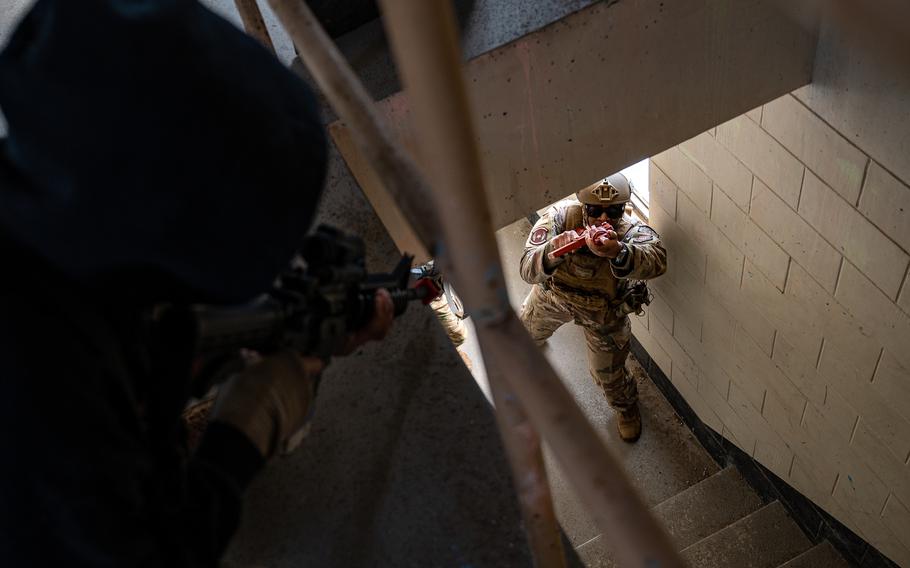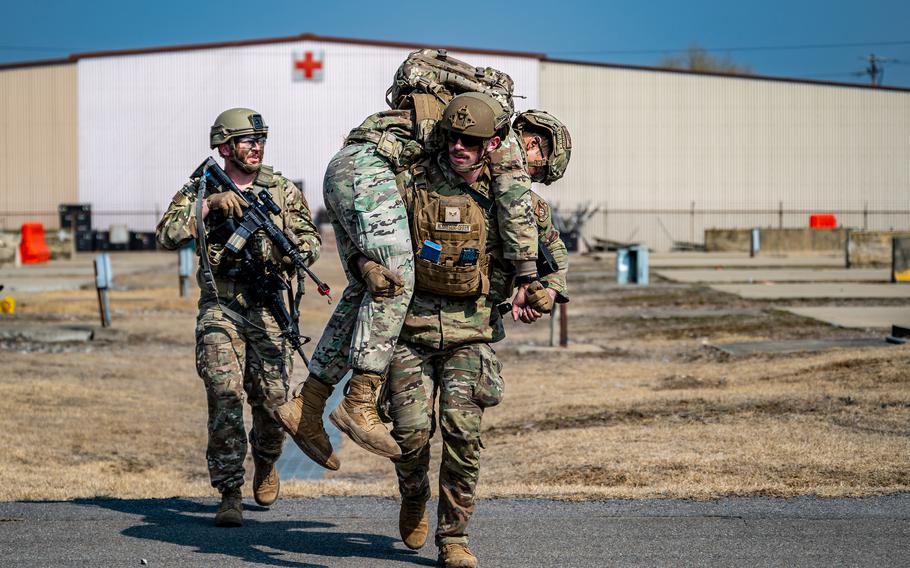
Staff Sgt. Jaelan Cearnel of the 51st Security Forces Squadron clears a room during the Combat Readiness Course at Osan Air Base, South Korea, March 14, 2024. (Thomas Sjoberg/U.S. Air Force)
OSAN AIR BASE, South Korea — Every month at this fighter base south of Seoul, security forces airmen spend 10 days honing the combat skills they need to fend off an attack on the installation.
The Combat Readiness Course is mandatory for the 450 members of the 51st Security Forces Squadron, but it is also open to other airmen. These volunteers, who primarily hail from non-combat arms units, are “really just making better defense for our … readiness,” Chief Master Sgt. James Tavenner told Stars and Stripes on Wednesday at the squadron’s headquarters.

Senior Airman Ethan McGregor, an aircraft parts store journeyman for the 51st Logistics Readiness Squadron, carries a mock casualty to safety during a Combat Readiness Course at Osan Air Base, South Korea, March 14, 2024. (Thomas Sjoberg/U.S. Air Force)
Around 40 airmen take part in the course, including roughly 20 who set aside their usual Air Force jobs to train as warriors.
Senior Airman Ethan McGregor-Offen, an aircraft parts store journeyman for the 51st Logistic Readiness Squadron, volunteered to attend the March course.
“I thought it was a great learning experience because I’ve never really done anything sort of like this,” he said Thursday.
Troops are taught to handle the M-4 rifle and maneuver in close-quarters combat, render first aid to casualties and perform operations using Humvees, Tech. Sgt. Zachary Wales, a senior course instructor, said Wednesday.
The course does not include aircraft and is mostly conducted on base in empty buildings simulating an enemy fortification, Wales said.
The objective is simple: ensure the security squadron airmen are proficient in combat and physically fit to deal with ground-based threats, Tavenner said. The airmen are stationed at Osan for about a year.
“With the recurring influx of people at this installation, we have to have this course at least once per month to ensure mission readiness,” Tavenner said.
The skills learned in the course are applicable throughout the airmen’s military career, he added.
McGregor-Offen said he took the course so he could pass on the weapons skills he learns to colleagues.
“God forbid something else were to happen, you’re more prepared for yourself and you can support … your teammates around you,” he said.
Rucksack marches were among the most difficult events of the course, McGregor-Offen said. Airmen marched a mile on the first day carrying a 35-pound rucksack and wearing body armor. That distance increased throughout the course until the troops marched five miles.
The Air Force needs “multi-capable airmen” like McGregor-Offen to perform basic military functions — from carrying out security operations to firearm familiarity — to become a more effective airman, Tavenner said.
“They’re held to the same exact standard as security forces,” Wales said. “None of the curriculum has changed. They’re given the right to bear arms along with security forces, so we treat them as such.”